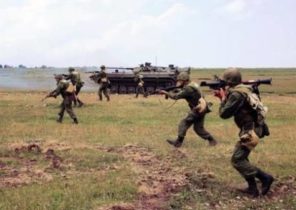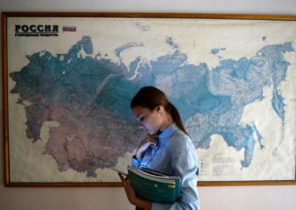
The sacred animal of Mongolia — chunky and with a massive head like a plump foal-age, which came in the most bizarre places. His torso the color of coffee with milk and legs are dark as if dressed in stockings. The muzzle is white, and black and bristly mane sticks out like svezhevyglazhennye Mohawk. Across the back, like the stripes of a racing car reaches a dark “belt”. Cubs often have a pale gray color and covered with hair like lambs. While any normal person would immediately want to Pat them or even hug, for wolves is nothing more than a tasty lunch.
If you had a chance to observe these animals in the wild — what to do is difficult, because their habitats are extremely limited — you would find that they have gregarious way of life, gathering in harems, groups of 5 to 15 individuals, where the dominant stallion watching over mares and their offspring. For this you should go to Mongolia, Kazakhstan, China or Russia — the only place on earth where the Przewalski’s horse lives in the wild. Not so long ago, this once prolific species in the steppes of Central Asia was only one harsh winter, one pack of hungry wolves, one outbreak is far from extinction.
This animal is known as “Przewalski horse” (pronounced shuh-VAL-skee), or for brevity, “P-horse” but the Mongols called her Taha, which means “spirit” or “worthy of worship”. Taha don’t ride, don’t have her in the stable and although this horse is extremely similar to the pony saddled her not to carry children on holidays. For these purposes, the horse is too wild. Until it was caught and not restricted outside of the zoo, Przewalski horse remains untamed: this is the only truly wild horse exists in nature. Other horses, whom we consider to be wild, really just run wild.
Currently, there are about two thousand Taha, and most of them live in the National Park hustai, 60 miles from the capital of Mongolia Ulan-Bator. I found it surprising that such a wild animal lives so close to the city with a population of 1.4 million people. But, as I recently discovered in Mongolia where the city ends, it immediately starts the countryside. Bright green hills of the Western province of Tuva has already spread beyond the last gas station, the last cluster of yurts, past Smoking chimneys, in the last as a janitor, which in the stream of rampant traffic makes absolutely futile effort, swinging on the dusty roadsides of their vast, like the witch’s straw broom.
When you clean the road and decent weather to Justa typically can be reached within a couple of hours. It is better to go by Land Cruiser, as did I and my guide. The last ten miles we passed along the road, shaking on bumpy dirt and raising clouds of reddish dust. The road skirted a convex sand dunes and fields of wheat and rapeseed, oil which is particularly popular in the Chinese market. Today in this area, the government allowed farmers, although experts on nature protection are afraid that such close proximity of crops and emerging species upset the balance of the ecosystem.
“This kind of horses is under threat of extinction — why did they sow the fields close to the Park?” later told me the wildlife biologist Hosta named Utuhegal “USCO” Dorje (Usukhjargal “Usku” Dorj). Away from all sides could be seen the low weathered mountains and to the South behind them stretched the desert of Gobi. Somewhere in the foothills, and grazing Tahi.
As once noted environmentalist Tserendeleg (J. Tserendeleg), “without the horses, Mongolia is not Mongolia”. For the national identity of the horse are so important that even the official flag of Mongolia is made from wool and horse tail. Along with the wild Tahi Mongols have their own local breed of horses, which supposedly keeps most of its characteristics from the time of Genghis Khan: this is a short, stocky, fast and powerful horse with a long tail and mane.
The Mongols able to ride these horses through the most impassable terrain — they are called the best riders in the world. Children are taught to deal with horses from the age of three in the Gobi desert often you can see small figures dressed in Delhi and shoes with curved toes, which are beasts for the bridle and the reins. Breeders who breed and graze horses, consider them family members.
Like it or not, but Genghis Khan would not have been a Genghis Khan without the Mongol horses: in the 13th century the Mongol Empire on horseback conquered half of Asia and Eastern Europe. The three “masculine” sports in Mongolia are wrestling, archery and, you guessed it, racing. At the summer festival Nadom, held annually in July, jockeys dip rear part of the body their horses in a lucky Mare’s milk, and then arrange the race by as much as 16 miles. Watch as dozens of horses and their riders reach the top of a distant hill and went down at a gallop through the pasture, seeing in motion a chain of ancient times.
On the other hand, Taha is as elusive as remarkable a horse. On the same day in Hustai we got in the car and went in search of them along the rocky road leading into the reserve. Behind the wheel sat the Director of the Park Dashuri Tserendeleg (Dashpurev Tserendeleg), or simply “dash” between USCO pans the hills with binoculars in hand. The horse did not appear, but everywhere in the short grass scurried fat marmots to hurry to hide in their burrows.
“Thirty seconds, four marmot,” reports USCO.
“They’re probably hungry,” the comments dash. In the last two days it rained, which, he suggested, did not allow the groundhogs to come out in search of food.
USKO mentioned three types of eagles that live in the Park, and pointed out the Falcon, which could track a grasshopper from the top of the cable. Across the road ran long-tailed ground squirrel. The Windows were lowered, there was a warm wind; a field filled with Stellarium crickets. Dash stopped at the object, which is rarely seen in the backwoods: white-blue Parking sign marked “P”. Grassy rectangle, lined with cobblestones, Parking designated area for supervision over the wild nature, where, as hoped USCO could be Tahi. Getting out of the SUV, he coughed and said, “the national symbol of Mongolia is the dust”.
To the naked eye it might seem that in the hills there was nothing but boulders and forest stands, some of the stones were so bizarre that it seemed as if they were made on purpose. “In some places they are similar to the ruins of the castle,” said dash. USKO set the tripod and the telescopic tube.
The first written mention of Taha date back to the 900-th year, when Tibetan monk named Bodova (Bodowa) wrote about these horses in their works. Later, as reported, horses drew the attention during their conquests, Genghis Khan. In the 15th century the German writer Johann Schiltberger (Johann Schiltberger) who accidentally saw a horse in Mongolia, being a prisoner of the Turks, wrote about Taha in his diary. And in 1630, Taha, is said to have been presented to the Emperor of Manchuria.
It is believed that this horse first opened in the 19th century geographer and Explorer Nikolai Przewalski, who served as an officer of the Russian army. In 1878, the Przewalski, returning from an expedition to Central Asia, was received as a gift from one of the dignitaries of the skull and the skin of the horse. The remains were studied in Saint Petersburg, in the Zoological Museum of the Russian Academy of Sciences, whose restovrator came to the conclusion that they belonged to wild horses, which is officially named Equus przewalskii.
Przewalski tried to hunt Taha, but “those sped by like a hurricane, and instantly disappeared from view,” wrote Inge and Jan Bouman (Inge and Jan Bouman) in the book “Przewalski’s Horse: the history and biology of endangered species”, edited by Lee Boyd (Lee Boyd) and Houpt Katherine A. (Katherine A. Houpt). Taha “was very shy and had a fine sense of smell, hearing and sight. They seem to hold salt steppes and in the long time to go without water”. Zoologists and lovers of exotic animals have interested in a capture of these horses, but it turned out to be a daunting task. Everything that could make the hunters were foals, most of which died shortly after capture.
At that time, the successful German buyer of animal by the name of Carl Hagenbeck (Carl Hagenbeck) were engaged in that collected all kinds of living creatures that could only find. The son of a lover of exotic animals, he was obsessed with this idea since the age of 14, when his father allegedly gave him a menagerie, including the polar bear and several seals. Traveling from one country to another, Hagenbeck has expanded its collection of captured animals. Not surprisingly, he died of complications from a snake bite. By the time Przewalski “discovered” Taha, Hagenbeck was engaged in trade in animals across Europe and the United States, he became known thanks to perfect them by the revolution in the zoos, where the preference was given not to the cells but pools with a play of natural habitat. He soon acquired Taha and sold them to the zoos of London, Cincinnati, Paris, Amsterdam, Hamburg and new York.
Hagenbeck, according to his own estimates, has caught at least 52 of the foal. The expedition for the capture of Taha lasted about 20 years. Capturing foals, hunters often killed the adult stallions that subsequently threatened the natural reproduction. The horse is also not very good feel in captivity; after the Second world war its population was reduced to 31 breeding horses that lived in Munich and Prague. Nine of them brought offspring. But by 1950 the population had dropped to 12. In 1959, a German zoologist collected stud book, which later led to the Prague zoo. There was organized a special group to save the subspecies, and by 1965, there were already 134 of the Przewalski horse, living in 32 zoos and private nurseries.
At the same time, a severe winter killed thousands of horses, and embossed pastures doomed to hunger the rest. The last group of Mongolian Taha was seen in about 1969. Then, apparently, the animal has ceased to exist in the wild. The Mongols, born and raised in 1970-e and 1980-e years, knew about Taha only the stories and photos.
Still took 20 years to programs for the conservation and breeding has shown its effectiveness, and the horse demonstrated the ability to survive. By 1990, its population grew to almost a thousand (961): these Przewalski’s horses lived in more than 129 institutions in 33 countries on four continents — that was enough to try to bring Taha to life on the outside. All living today under natural conditions Tahi descended from only 12 caught horses and a few crossed breeds.
In 2008, veterinarians at the Smithsonian institution contributed to the longevity Taha, reversing a vasectomy (done by another institution in order to prevent the offspring of females who lived with the stallion), and in 2012, making artificial insemination of one of the mares. “Today we deeply regret the loss of so many wild Przewalski’s horses at the turn of the century, when attempts were made the capture and transport of foals, but… if this hadn’t happened, this would almost certainly have disappeared — we read in the book of Boyd and Houpt. — Example of preservation of the Przewalski horse shows us that mass extinction is difficult to predict, and therefore to be extremely important in the captive population, you can count on, if there is a need for reintroduction”.
1990s, when Mongolia transitioned to democracy, became an ideal time to get the horse in its natural habitat. As told to me during a trip in hustai my guide, co-founder of Mongolia Quest, a company engaged in natural and cultural heritage, Geralton Dudorov (Gereltuv Dashdoorov), the change of political regime allowed to move forward projects that would not have been possible under socialism. He said, “It is as if Mongolia has suffered a lack of oxygen, and suddenly the door would be open and everyone frantically began to suffice a mouth air”.
In Mongolia, there are three places where Taha embedded in their natural habitat, and during my visit to the country, Claudia faye (Claudia Feh), one of the world’s leading experts on the Przewalski’s horse, was one of these objects, in the Western region Hominal, a two-hour flight and then a six-hour drive from the capital Ulaanbaatar.
Swiss autoecology specializing in equids, faye passionately fond of wild horses at the age of 19, saw a cave painting made 17 thousand years ago in the cave of Lascaux, France. For the first time she saw Tahi at the zoo. “She was great! once she said to me on Skype. But at the same time, I was a little sad to see her behind bars of a zoo — so it was mixed feelings. Horses are steppe animals. They need open space.”
For over 20 years the fairies tried to reverse the trajectory of extinction Tahi. In 1993 she moved to 11 born in the zoo of horses to France and begin to breed. About ten years later she introduced Tahi in family groups in Comentale, near the National Park of Khar Us Nuur, which is a six-hour drive from the nearest more or less respectable airport. When there was brought the first horses, faye and her team followed them in the cargo hold, feeding hay and apples and telling stories, the horses remained calm.
The plane landed on the mud on the runway, marked by a red flag fluttered in the wind. A crowd gathered, someone he rode on his horse hundreds of miles to again or for the first time to see Tahi. Before releasing the animals, dressed in Delhi volunteers milk sprayed the containers with the horses.
A Park Ranger named Shakhmatov Sandiego (Sanjmyatav Tsendeekhuu) once saw this kind of release of horses in Hustai. Great tall 45-year-old boy with a baby face, and when I met him in Hustai, he was wearing a baggy green uniform, cap, army boots and badge. He just returned from Minnesota where in the zoo was held a training course on the capture of wild animals without causing them harm. If earlier Cardeau carried out a patrol on horseback, he now drives a motorcycle and carries a gun that shoots rubber bullets in case he met the poachers hunted groundhogs.
He began working in Hustai in 1994 and was there that day when the containers Taha arrived on the cargo plane. Ventilated boxes with horses was exhibited among the fields and Andeeno took a position at the gate. At the signal, he and others at the same time raised the sliding door of drawers. Some horses recoiled, while others timidly stepped forward, before he realized that they are free.
“I felt a special feeling, comparable to the birth of my son and daughter,” said I Sandiego.
Colleagues fairies put in her credit that she was one of the first drew the attention of the Mongols to the importance of the protection of Taha. “It is impossible to protect the species without protecting the environment”, — it convinces local residents. Faye explains that the main incentive for the preservation of the horse was the realization that in our hands the salvation of all. “The idea was not only that, they say, well, let’s bring Taha back home, she says to me. — The idea was to preserve the view, which threatened the most serious danger of extinction”.
The old dangers have not gone away — the harsh winters, predators, hybridization with three million domestic horses in Mongolia. “Twelve or thirteen horses it’s a very narrow genetic basis,” said faye, but later added that, according to a recent study, the Przewalski’s horse exhibit remarkably high genetic diversity, which inspires certain optimism. “The main task is to ensure that the population is large enough to avoid too much inbreeding. To solve this problem will be very difficult”.
USCO, a biologist and expert on wild 36 — year-old lanky male with the energy of a young stallion explained something similar during a slide show in the second half of the day in Hustai. Before we went in search of Taha, he was standing on a small platform in front of the projector screen, in jeans and moccasins, a striped shirt and round glasses. His audience consisted of a dozen British bird watchers in the field vests and cameras sitting in a darkened meeting tent, which was a short walk from the Yurt visitor center, next to a Yurt gift shop. In hustai attracts many wildlife enthusiasts. In the Park you can observe over 50 species of mammals, over 200 species of birds and over 400 species of plants: poppies, violets, bushes of red currant, scarlet lilies, daisies before dawn.
You can select the route through the wild nature, flowers, birds also have a program for the care of the foal. The Park is spread amongst the lower spurs of the mountains Handiski, marked by the blue iron gates. Tourists stay in three dozen Yurt with a low brightly painted doors; in the summer you can see them in sandals and shorts or cargo trousers to hang wet clothes in the sun or striding into the dining room, which was located in a building of brown brick with offices and bathrooms. When I stayed there, the tables and chairs in the dining room was decorated with satin fabric peach color, like the expected wedding reception.
The menu fits Western tastes: beef stew, white rice, pasta, feathers krasnokochannoy cabbage, but there was a thermos of traditional Mongolian milk tea, salty and strong. The walls were hung with photographs of wildlife, which can be found on 125 thousand acre Justa: here were deer, lynx, rabbits and rams with huge horns, twisted bun like Princess Leia. Taha tantalizingly appeared in photos in all its glory, and one of the posters could read “Land of wild horses”.
About a year after arriving in hustai first batch Tahi Park was registered as a protected nature preserve; in 1998 Justy received the status of national Park. For ten years he worked thanks to donations from Dutch defenders of nature. Today, the independent, hustai operates on grants and tourism, as well as working on the development of ecotourism. Turning to British ornithologists, Osku explained that justi returned to the natural habitat of more Tahi than any other of the seven existing in the world reintroduction centers: the Park has over 350 horses and intends to expand the population.
On the slides he showed graphics and images Taha, explaining that some attempts at integration failed while others have succeeded. Some of the horses could not be released into the wild from zoos after the animals needed “polusharovidnye” zone, a kind of base camp in a fenced enclosure to acclimate. “Everything is instantly released into the wild animals died in the first year”, — was reported in one of the slides. USKO told the group: “Without adaptation to animals is extremely difficult!”
“Tahi love the land where they were born,” continued USCO. Although Mongolia is not a lot of fences, horses prefer not to go far. They feed on grass, fire, fescue. The growth in the number of Przewalski’s horses are also increasing populations of deer, marmots, gazelles, and sheep. Here USKO told the terrible news: it turns out that tourists vacationing in the place which can be called the camp of Darwin. Annually wolves kill here between 8 and 12 foals and foresters is known to shoot the wolves. Despite the fact that the staff Hosta follow a horse so closely that they know their harem and age, they try not to interfere. With a deep conviction USKO told his audience: “there Should be natural causes.”
In the distance, as if behind the scenes, I heard a spirited neigh. Squinting through a telescope, Usku exclaimed: “There! And there and there and there!” Stepping back, he gave me a telescopic camera.
The place that was directed telescope USCO, was still completely empty. But as soon as I pressed my eye to the glass, the eyepiece, as if by magic, arose a horse.
Taha grazed. They waved their tails, raised her head, watching the foals. Through the tube they seemed so close that you can Pat them. I’m so looking forward to meeting these horses that were expected to experience an overwhelming sense of surprise or fear, but seeing an animal once on the verge of extinction, I felt gratitude for the fact that all can see. It was easy to understand why people like USKO or fairies decide to devote his life to saving Tahi.
“Everything that has happened over the last 20 or 30 years, very cool, but this species is still under threat, later told us fairies. — We need larger populations, more populations. In the long term we have no guarantees. When talking about the preservation of species — for example, my time frame is something like four million years.”
USKO again swept the mountains telescope. Finding a herd of deer, he handed the tube Dasha, who, looking at her, said, “Definitely more than 50!” At the time the tour bus arrived British bird watchers and stopped in the Parking lot. In silence they got off the bus and began to set up their tripods and cameras.
“In these mountains a lot of horses,” said quietly to them Uscu.
“We can come to know him better?” — asked one.
“Yes, of course, because it’s tourist corridor,’ replied USKO. — We will be able to see them when they come down to the water.”
Usually the horses come to drink in the cool of the day, early morning and after dark, he explained. For the wolves they are most vulnerable at night, as well as near forests. “When you approach the wolves, the whole harem tries to protect babies, he said. The wolf attacks when the harem is relaxing”.
Well, well — on-tour I noticed.
USCO shook his head: “Even a wolf trying to survive. If you look at the situation from the point of view of the wolf, he needs to eat that baby. Wolves and horses are raised one against the other armies. We call it co-evolution”.
Watching the horses, some of ornithologists were asked how they graze. To answer this question, Uscu went to the field. He looked for something on the ground and returned with a handful of dried horse manure. When he broke it to pieces, the wind in the dry grass. “See, all this fiber, he said. — They eat a lot, but digest very little. All the time they graze. You can see how the deer are. But not horses. A large part of their life they eat. If they lose energy, don’t survive.”
“Distinguishable from each other harems?” — asked someone. Yes, said USKO. Harem, which the Park staff nicknamed burgad, or eagle, is especially fond of him for his carelessness. “You can see them almost every day. The area of a harem differs constancy”. Other harems sometimes disappear for a few days. USKO added that every year the struggle for the female die of his wounds two or three stallion: after a blow to the head or a broken Achilles tendon. “!If you are curious to see some truly horrible photos of death, I can show you on the computer,” said USKO. Unlucky in love stallions form the group of “bachelors” and wander together.
“Sometimes stallions have no chance to catch the female, said USKO. — Then no sex.”
“Sadly,” said dash.
“That’s life”, — stated USCO.
When talking about the sexual life of horses came to an end, we’re back in the Land Cruiser and drove on. We passed a hoopoe, sandpipers, slipped past the gophers with even longer tails. In the former field station of the Park, the two-storey building, blue Mongolian sky, two students were washed with water from the well. USKO drew attention to the dark green grass and nettles. Dash pointed to the plant from raspberry flowers which his grandmother gave him the broth from abdominal pain. There were marmots and began to scurry back and forth. “In other regions of Mongolia marmots fearful, said USKO. — But not us.”
We stopped at the source, where Tahi often come to drink. USCO have collected water in the palm of your hand and took a SIP. Then he stood up, covering his eyes, and looked at the sky: “Steppe eagle. Three years. Non-breeding bird.” The eagle descended, circling, and disappeared out of sight.
Since it was a hot day, explained Usku, horses do not come to the watering hole before dark. We went back toward the camp. During this time the watchers are not moved; they stayed in the same place where we saw them last time, and watched Amur Falcon. The whole bus stared at the bird in silence, as if it were a small room in the theatre, breathlessly watching the show. After a little while, USCO announced: “the eagle. Molting”.
We were driving in the green countryside of the hills that in the next few weeks will be the autumn yellow. In Mongolia, the distant mountains always seem so close, and just when it starts to move quite a large animal, distance clarified. Something moved among the rocks, crossing the slope from right to left. Now it seemed that the mountain was covered with ripples. Night was falling, it jumped Tahi.







